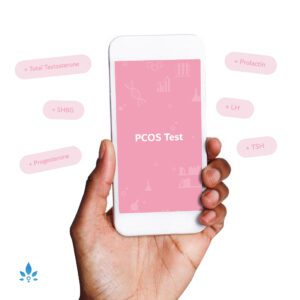Five Things Your Doctor Probably Won’t Tell You About PCOS (Polycystic Ovary Syndrome)


-
There are different types of PCOS
-
The main symptom of PCOS is not polycystic ovaries
-
Two out of three symptoms are required for a PCOS diagnosis
-
Artificial hormones (like the combined contraceptive pill) do not cure PCOS, they mask the effects
-
The best way of managing PCOS is with changes to the diet and lifestyle
PCOS (Polycystic Ovary Syndrome)
PCOS (Polycystic Ovary Syndrome) is a very common endocrine disorder that is normally diagnosed in women of reproductive age. That is not to say that these are the only females affected, the condition has also been identified in children, with current research suggesting that some women are genetically predisposed to PCOS from before birth. Furthermore, if it is not managed successfully, the full impact of the associated symptoms of PCOS can be felt well beyond the menopause. This highlights the need for further research and a better understanding of the condition, not least because it has a suspected incidence rate of between 4 and 10% and, to date, remains not particularly well understood and, in some cases, not particularly well managed clinically.
In this article we highlight some of the facts about PCOS that are not widely known. We will explore why there can never be a simple one step solution to treating the condition and how important taking a personalised approach to treatment is.
1) There are different types of PCOS
It is becoming increasingly apparent that there is no single causative factor that leads to the development of PCOS. Rather, it is likely to occur due to a complex interplay between various factors, including, but not limited to, genetic susceptibility, environmental factors, dysregulated hormone levels and metabolic status.
If we take a step back from diagnosing PCOS as a standalone condition and instead characterize it according to its predominant symptom or likely cause, we will be in a far better position to successfully manage the negative effects.
Insulin resistant form
The most prevalent type of PCOS is the insulin resistant form. Insulin resistance affects up to 70% of women with PCOS and an increase in circulating insulin levels probably contributes to at least two of the three major clinical symptoms of the condition. The condition might be hyperandrogenism and menstrual irregularities.
Innocuous follicular cysts
Innocuous follicular cysts are common, particularly in young women. They form when a follicle containing an egg does not open to release the egg, and they are termed partially mature. In the absence of other PCOS symptoms, they are usually benign in nature and nothing to worry about.
The Rotterdam consensus in 2003 defined a polycystic ovary as one with more than 12 follicular cysts and an ovarian volume of 10ml or greater. Transvaginal ultrasound scans are useful for determining this, but should never be used in isolation for PCOS diagnosis. One other clinical symptom is required for an accurate diagnosis.
Continuing with this mode of PCOS characterization, other forms of the condition include;
-
Pill-induced PCOS
-
Inflammatory PCOS
-
And hidden cause PCOS. For a detailed review on all of these, click here.
The key thing to note is that not every treatment option will be suitable for every woman with PCOS. The combined oral contraceptive pill is frequently prescribed. However, as some oral contraceptives can increase insulin resistance it will not usually be suitable for women who present with this type of PCOS.
No single cause, means no single treatment and a personalised, multidisciplinary approach is usually required.
2) The main symptom of PCOS is not polycystic ovaries
PCOS is not well named; polycystic ovaries are not required for a diagnosis and, just to add to the complexity, it is quite possible to have ovarian cysts, but not PCOS. An alternative name for PCOS is hyperandrogenic anovulation, which, whilst less easy to articulate, is certainly a more accurate definition. Literally meaning an excess of male hormones and lack of ovulation, this much more closely describes the most common phenotypes of the condition.
Polycystic ovaries do remain a clinically recognized symptom of PCOS and it is estimated that 75% of women with PCOS will have abnormal ovarian morphology. However, up to a quarter of all women of reproductive age will have some degree of ovarian abnormality, suggesting that the false positive rate is high.
Symptoms of PCOS
Hyperandrogenism
Hyperandrogenism is one of the main symptoms of PCOS. However, even this is not straightforward as the excess androgens can be secreted by either the ovaries or the adrenal gland. If they come from the adrenal gland ( 25-50% of cases), it might be that the symptoms of PCOS are actually due to an adrenal disorder such as micronodular adrenocortical hyperplasia. This will require different management to ovarian androgen excess.
In cases where there is a causative pathology, such as an underactive thyroid gland, solving the underlying problem is very likely to relieve the PCOS symptoms. For hypothyroidism, thyroid hormone medication can help.
3) Two out of three symptoms are required for a PCOS diagnosis
In 2003 the Rotterdam Consensus Workshop was established to redefine the optimum diagnostic criteria for PCOS. This had not been reviewed in detail since the National Institute of Health (NIH) established guidelines for diagnosis in 1990.
The outcome of the Rotterdam consensus was the classification of three clinical symptoms, indicative of PCOS:
- Hyperandrogenism
- Menstrual irregularity
- Polycystic ovaries.
The consortium concluded that a patient should present with at least two of these symptoms before a positive PCOS diagnosis can be made, try our own PCOS Test first. You can track your cycle and learn if you are experiencing menstrual irregularity using the Nabta cycle tracking app.
Common features of PCOS
The review panels held to date have recognized a number of other common features of PCOS, including insulin resistance, obesity and elevated levels of luteinizing hormone in the serum. Although their presence is often considered intrinsic to PCOS, none are yet recommended for use in its diagnosis. Rather, women with PCOS are considered to be at greater risk of developing insulin resistance and obesity.
Our understanding of PCOS increases, it is apparent that insulin sensitivity is fundamental to the development of many of the other symptoms of the condition. These are hyperandrogenism, irregular menstruation, obesity and a predisposition to other metabolic conditions, to name just some.
Treating insulin resistance has also been shown to improve the symptoms of PCOS. Providing further evidence that a deficiency in insulin signaling may be key to the pathogenesis. It is may also be of the condition in a large number of women.
Measuring insulin resistance directly is neither straight forward nor particularly accurate, a more reliable means of measuring insulin metabolism. However, it is required and work to identify a reliable biomarker is on-going. Suggestions to date, include adiponectin, complement component C3 and FGF21. Early identification of insulin resistance would mean preventative measures could be instigated in an attempt to alleviate other PCOS-like symptoms.
4) Artificial hormones (such as the combined oral contraceptive pill) do not cure PCOS, they mask the effects
Oral Contraceptive Pill
One of the main treatment options for PCOS is the combined oral contraceptive pill (‘the pill’). In theory, using the pill makes sense. If PCOS is considered to be an endocrine system disorder, then regulating hormone levels should ease the symptoms.
The combined pill contains an oestrogen component that is anti-androgenic in nature and a progesterone component, which suppresses secretion of luteinizing hormone. In combination this reduces some of the signs of hyperandrogenism. For example, acne and hirsutism, and, seemingly, regulates the menstrual cycle.
Female Infetility
PCOS is one of the predominant causes of female infertility, thought to be responsible for up to 70% of cases. Despite its widespread use, the pill is not an ideal solution for improving fertility. Nor is it a long-term solution for any woman with PCOS (Polycystic Ovary Syndrome). This is because any therapeutic effects it might appear to exhibit, only really mask the problems. However, taking the pill does not resolve the underlying issues. The menstrual cycle is not actually being regulated because the monthly bleeds experienced are pill withdrawal bleeds, not normal menstruation, so regular, cyclical ovulation is still not occurring.
Cycle regulation
This can lead to disappointment for those women who have been taking the pill with the hope of regulating their cycles, so that upon withdrawal they can become pregnant. If they had irregular cycles before going on the pill, they are highly likely to revert back to a similar state once they stop taking it. The idea that there is a form of PCOS that can be directly attributed to current, or previous, use of the oral contraceptive pill. It is becoming more widely accepted by the medical and scientific communities. This can cause women who have never had PCOS symptoms before to start experiencing some of the common complaints of the condition, including infetility.
In addition to this, metabolic conditions, which are a common comorbidity alongside PCOS, can be exacerbated, or triggered by some versions of the combined oral contraceptive pill.
Why not the Pill
The pill is not without its own risks and side effects and these should be carefully considered prior to commencing treatment. If there is any familial history of thrombosis, or a prior diagnosis of hypertension or diabetes, an alternative treatment should be sought. Non-hormonal treatments are also recommended for those who present with multiple risk factors for cardiovascular disease.
Although a lot of clinical guidelines recommend its use, many studies on the effectiveness of the pill to treat hormonal conditions, were performed using women who did not have PCOS. Furthermore, it must be remembered that the components of the pill are synthetic; artificial versions of the hormones they are attempting to replicate. Structurally similar, there are fundamental differences. For example, naturally occurring progesterone is a happy hormone, demonstrated to relieve anxiety. It’s synthetic analogue, progestin, is associated with a depressive mood, low libido and feelings of negativity.
In conclusion to this;
Taking all of this into account, it would be a miss to say that the pill is completely redundant in the treatment of PCOS. It does bring symptomatic relief to a lot of women, particularly those with heavily hyperandrogenic PCOS (Polycystic Ovary Syndrome). As a means of birth control, it is one of the most widely used options available. It also appears to reduce the risk of developing endometrial cancer. Women with PCOS are up to three times more likely to be diagnosed with endometrial cancer, due to unopposed exposure of the uterus to oestrogen. Taking the pill could significantly reduce this risk.
Thus, the pill should not be disregarded as an option for treating PCOS, but doctors should be prepared to explore other options alongside or in place of it. That is not seeing it as the treatment of choice for all patients.
5) The best way of managing PCOS (Polycystic Ovary Syndrome) is with changes to the diet and lifestyle
Medicines to Manage PCOS
For all the advancements that have been made in medical science, for all the life-enhancing and life-prolonging drugs that are currently available. For all that our knowledge on the pathogenesis of PCOS is expanding; one simple fact remains true. The best way of managing the symptoms of the condition is through making careful, well thought out, changes to both lifestyle and diet.
As described above, medications are often used to treat the condition: the pill is commonly prescribed to manage the symptoms of excess androgens. Metformin, an anti-diabetic drug, is widely used to manage insulin resistance (even though studies on its effectiveness are contradictory); and clomiphene citrate is regularly used to treat infertility. Short-term relief from symptoms is one thing, but it is far better to identify and eradicate the cause of PCOS, with a view to providing permanent symptomatic relief.
With such a multi-factorial condition, there is never going to be a simple solution. However, adopting a healthier lifestyle and a more nutritionally balanced diet has been shown to improve many of the symptoms, including insulin resistance and infertility. A loss of weight has been shown to improve fertility and increase live birth rates in women with PCOS (Polycystic Ovary Syndrome). In one study, 80% of women experiencing anovulation and infertility started having regular menstrual cycles after losing 5% of their body weight. Furthermore, 40% of these women went on to fall pregnant.
Doctors to consult
Dr. Majeda Al-Azemi, a consultant and professor of Obstetrics and Genecology at Kuwait University, estimates that over 50% of PCOS cases can be reversed by weight loss alone. Thus demonstrated the huge potential of adopting a healthy diet, not only for providing symptomatic relief, but also in alleviating the need to take long-term medication.
Even those who have a genetic predisposition to the condition, such as babies born with heightened levels of anti-Müllerian hormone, go on to develop PCOS-like symptoms in adulthood. They can take preventative steps to minimize the impact, through maintaining a healthy BMI and a balanced diet.
To have PCOS (Polycystic Ovary Syndrome) is to exist in a state of chronic, low-grade inflammation. Thus, adopting an anti-inflammatory diet can only help. Avoiding processed food, tobacco, excess alcohol; minimizing sugar intake is important for the management of insulin resistance. However, avoiding exposure to harmful environmental irritants, including endocrine disruptors also manage insulin resistance. Supplementing your diet with magnesium, which is anti-inflammatory, but also naturally lowers insulin levels. However, consulting a naturopathic doctor, who can advise on which herbal or natural medications may work on a case-by-case basis. All of these factors can help.
Diet Options
Adopting a good, well balanced diet not only lowers BMI and improves body composition, but also promotes hormonal balance. However, it also improves menstrual regularity, increases spontaneous pregnancy rates, lowers blood pressure, and reduces blood glucose levels. The longer term risk of developing associated conditions and health complications, such as diabetes type 2, are also reduced. Women who have insulin resistance are also at a higher risk of developing gestational diabetes. It can lead to complications such as polyhydramnios, pre-eclampsia, pre-term delivery and large birth weight, as well as increasing the risk of foetal mortality.
Conclusion
PCOS (Polycystic Ovary Syndrome) is a syndrome, with a range of associated symptoms. Not all symptoms will affect every patient. The best management of the condition comes from having a better understanding of your own body. Making lifestyle changes will not only improve your PCOS symptoms, but also your general health and wellbeing. A PCOS diagnosis does not need to be a lifelong affliction; it should be life-changing, but for the better, not for the worse.
Consider Nabta’s PCOS test and get yourself a PCOS pack.
Sources:
- Azziz, R, et al. “Positions Statement: Criteria for Defining Polycystic Ovary Syndrome as a Predominantly Hyperandrogenic Syndrome: an Androgen Excess Society Guideline.” The Journal of Clinical Endocrinology and Metabolism, vol. 91, no. 11, Nov. 2006, pp. 4237–4245., doi:10.1210/jc.2006-0178.
- Balen, A H, et al. “Ultrasound Assessment of the Polycystic Ovary: International Consensus Definitions.” Human Reproduction Update, vol. 9, no. 6, 2003, pp. 505–514.
- Crosignani, P G, et al. “Overweight and Obese Anovulatory Patients with Polycystic Ovaries: Parallel Improvements in Anthropometric Indices, Ovarian Physiology and Fertility Rate Induced by Diet.” Human Reproduction, vol. 18, no. 9, Sept. 2003, pp. 1928–1932.
- De Melo, A S, et al. “Hormonal Contraception in Women with Polycystic Ovary Syndrome: Choices, Challenges, and Noncontraceptive Benefits.” Open Access Journal of Contraception, vol. 8, 2 Feb. 2017, pp. 13–23., doi:10.2147/OAJC.S85543.
- El Hayak, S, et al. “Poly Cystic Ovarian Syndrome: An Updated Overview.” Frontiers in Physiology, vol. 7, 5 Apr. 2016, p. 124., doi:10.3389/fphys.2016.00124.
- Gourgari, E, et al. “Bilateral Adrenal Hyperplasia as a Possible Mechanism for Hyperandrogenism in Women With Polycystic Ovary Syndrome.” The Journal of Clinical Endocrinology and Metabolism, vol. 101, no. 9, Sept. 2016, pp. 3353–3360., doi:10.1210/jc.2015-4019.
- Marshall, J C, and A Dunaif. “Should All Women with PCOS Be Treated for Insulin Resistance?” Fertility and Sterility, vol. 97, no. 1, Jan. 2012, pp. 18–22., doi:10.1016/j.fertnstert.2011.11.036.
- Niafar, M, and N D Nader. “Adiponectin as Serum Biomarker of Insulin Resistance in Patients with Polycystic Ovarian Syndrome.” Gynecological Endocrinology, vol. 31, no. 6, June 2015, pp. 473–476., doi:10.3109/09513590.2015.1008445.
- Norman, R J, et al. “The Role of Lifestyle Modification in Polycystic Ovary Syndrome.” Trends in Endocrinology and Metabolism, vol. 13, no. 6, Aug. 2002, pp. 251–257.
- Patel, S. “Polycystic Ovary Syndrome (PCOS), an Inflammatory, Systemic, Lifestyle Endocrinopathy.” The Journal of Steroid Biochemistry and Molecular Biology, vol. 182, Sept. 2018, pp. 27–36., doi:10.1016/j.jsbmb.2018.04.008.
- Polak, K, et al. “New Markers of Insulin Resistance in Polycystic Ovary Syndrome.” Journal of Endocrinological Investigation, vol. 40, no. 1, Jan. 2017, pp. 1–8., doi:10.1007/s40618-016-0523-8.
- Rotterdam ESHRE/ASRM-Sponsored PCOS Consensus Workshop Group. “Revised 2003 Consensus on Diagnostic Criteria and Long-Term Health Risks Related to Polycystic Ovary Syndrome.” Fertility and Sterility, vol. 81, no. 1, Jan. 2004, pp. 19–25.
- Salama, A A, et al. “Anti-Inflammatory Dietary Combo in Overweight and Obese Women with Polycystic Ovary Syndrome.” North American Journal of Medical Sciences, vol. 7, no. 7, July 2015, pp. 310–316., doi:10.4103/1947-2714.161246.
- Shokrpou, M, and Z Asemi. “The Effects of Magnesium and Vitamin E Co-Supplementation on Hormonal Status and Biomarkers of Inflammation and Oxidative Stress in Women with Polycystic Ovary Syndrome.” Biological Trace Element Research, 18 Dec. 2018, doi 10.1007/s12011-018-1602-9.
- Tata, B, et al. “Elevated Prenatal Anti-Müllerian Hormone Reprograms the Fetus and Induces Polycystic Ovary Syndrome in Adulthood.” Nature Medicine, vol. 24, no. 6, June 2018, pp. 834–846., doi:10.1038/s41591-018-0035-5.
- Briden, L. “Treatment for 4 Types of PCOS. Treat the Cause.” Lara Briden – The Period Revolutionary, 16 May 2014, www.larabriden.com/treatment-for-4-types-of-pcos-treat-the-cause/.
- “How Do Health Care Providers Diagnose PCOS?” National Institute of Health, www.nichd.nih.gov/health/topics/pcos/conditioninfo/diagnose. Last Reviewed Date 31/1/2017.
- Overview: Gestational Diabetes. NHS, www.nhs.uk/conditions/gestational-diabetes/. Page last reviewed: 05/08/2016.













































